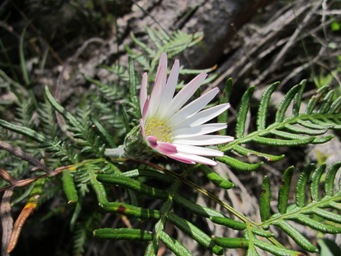Australia So Much to See
Copyright (C) 2013 AustraliaSoMuchtoSee.com. All reights reserved
Sources used for identification of wildflowers shown on these pages and regions where they occur see Credits
These pages will
feature some of the wildflowers we have photographed in Western Australia, and where possible, identified. If you
are able to help identify further flowers, or correct any I may have wrong, please contact us.
Information given for each species
will give botanical name, known common names, describe the flower, give time of year it flowered, and where it was photographed, and
the areas it occurs in. Names have been matched to Florabase which has also been used to show distribution.
To see
more Western Australian Wildflowers, see WA Now and Then Wildflower Gallery
See some of these wildflower
in larger sized photos on our Flickr pages.
Trichocline spathulata Native Gerbera (previously known as Amblysperma spathulatum and Amblysperma spathulata)
A many petalled
single large white daisy on a tall stem of up to one metre high from oval shaped base leaves with an irregular edge at ground
level. Slight serrations at tips of petals. Pink on maroon on buds and rear of petals. Centre above right has
a pink touch showing from the maroon petal backing.
November December
Bridgetown, South West region, Western Australia and occurs
over a wide distribution from Shark Bay to the south coast east of Esperance, in the Gascoyne, Mid West, Wheatbelt, South West and
Great Southern and Goldfields regions

Trachymene pilosa, Native Parsnip
Very small clusters of white flowers, and curled furry seeds heads
October
Bridgetown, South West region,
Western Australia and occurs in the Wheatbelt, South West and Great Southern regions








Common names are merely descriptive nicknames. Trachymene pilosa along with Trachymene anisocarpa are known as Native Parsnip,
but they are in the Araliaceae family. There is also a non-native plant known as Wild Parsnip which is in the Apiaceae family,
as is the vegetable Parsnip.
Trichocline spathulata is in the Asteraceae (daisy) family, as is the garden Gerbera (and other daisies native and non-native), so
it is in fact related to the garden Gerbera.